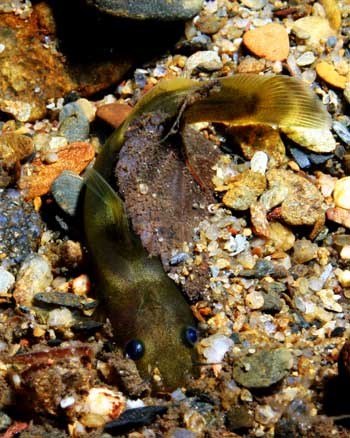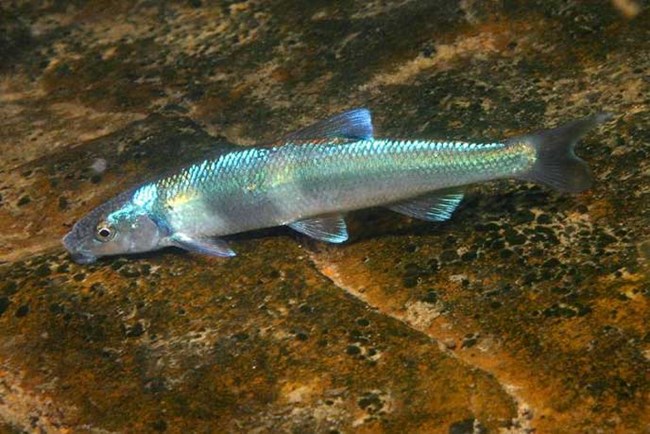|
Introduction Abrams Creek, just one of Great Smoky Mountains National Park's many fish-inhabited streams, is a hotbed for native aquatic life. This stream once supported the highest species diversity of any given area in the park. Unfortunately, human intervention has harmed these populations, and many species have since become endangered. Extensive research and effort has been invested in restoring these diverse habitats. 
Conservation Fisheries, Inc. photo History Abrams Creek flows from Cades Cove to the Little Tennessee River, with an upper and lower section divided by Abrams Falls. The level land surrounding the lower section of the creek was important farmland to early European settlers. In 1957, the U.S. Fish and Wildlife Service removed Rainbow Trout (Oncorhynchus mykiss) in partnership with the National Park Service for recreational purposes. In order to allow the Rainbow Trout to grow without competition, nearly all of the more than 30 native species of fish were removed using the fish pesticide rotenone. Also in 1957, the construction of the Chilhowee Reservoir was completed, and the lower two miles of the stream were flooded. Stream fish were now living in an unfamiliar lake habitat, and all either died or were displaced. The unnatural removal of species coupled with the flooding of the lower 2 miles of stream due to impoundment has caused a sharp decline in the diversity of this area and prevented a natural recolonization of many species. Current Status Of the affected species, two have been recognized as federally endangered, the Smoky Madtom (Noturus baileyi) and the Citico Darter (Etheostoma sitikuense). The Yellowfin Madtom (Noturus flavipinis) and Spotfin Chub (Erimonax monachus) have been recognized as federally threatened. Between 1986-2001, individuals of these four species were collected from surrounding habitats and reintroduced to Abrams Creek in an effort to reestablish viable populations of each and ultimately remove them from the Endangered Species list. Since restoration efforts began, research has shown that the Madtom species and Citico Darters have established reproductive populations, and are at 50% and 100% of their former capacity, respectively. Spotfin Chubs have not been able to survive. Recent studies by Gibbs (2014) demonstrate that the spotfin chub could not survive in Abrams Creek due to the fact that there is large downstream river system remaining. Spotfin chub use mid-size streams like Abrams Creek for summer habitat, but need larger rivers in the winter and to sustain the larger population. Future Progress While three of the four endangered species are showing improvement, the creek's isolated location is still a concern; if new genes aren't flowing into the creek, genetic diversity will never thrive. Without a natural way for new genes to arrive, steps must be taken to avoid inbreeding and encourage adaptive processes. As a result, the plan is to relocate 1-2 adult individuals per year between Abrams Creek and nearby Citico Creek. With continued practice and monitoring, the transplants will allow for new traits to be introduced within the isolated gene pools and promote a healthier population for the future. 
Conservation Fisheries, Inc. photo
To learn about the microhabitat usage of the Citico Darter, Smoky Madtom, and the Yellowfin Madtom, please go to: https://irma.nps.gov/App/Reference/Profile/2173302 To learn about the status of two other species inhabiting Abrams Creek, the Threatened Spotfin Chub (Erimonax monachus) and the Endangered Duskytail Darter (Etheostoma percnurum), please go to: https://irma.nps.gov/App/Reference/Profile/2173296 For more information about the reintroduction of Smoky Madtoms and Yellowfin Madtoms in Abrams Creek, please go to: https://irma.nps.gov/App/Reference/Profile/662536 For in-depth analysis of the microhabitat and macrohabitat usage of the Smoky Madtom and Yellowfin Madtom, as well as a description of the function of this research for the future, please go to: https://irma.nps.gov/App/Reference/Profile/2207826 To learn about the practice of relocating fish for the sake of genetic integrity, please go to: https://irma.nps.gov/App/Reference/Profile/2220949 Prepared by Jason Brown. References Simbeck, Damien J. Distribution of the Fishes of the Great Smoky Mountains National Park. Thesis. University of Tennessee, 1990. N.p.: n.p., n.d. Print. Gibbs, W.K. "Summer Habitat Use and Partitioning by Two Reintroduced Rare Madtom Species." Journal of Freshwater Ecology (2014). Print. Kulp, Matt, and Steve Moore. Threatened And Endangered Fish Translocation To And From Abrams Creek, Citico Creek And Tellico River, Great Smoky Mountains National Park And Cherokee National Forest. U.S. Department of the Interior, National Park Service, 2015. Print. |
Last updated: August 7, 2015
